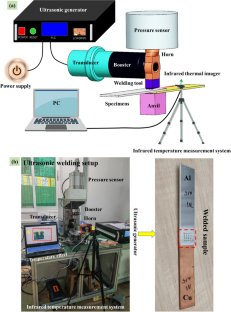The International Journal of Advanced Manufacturing Technology ( IF 3.4 ) Pub Date : 2024-04-10 , DOI: 10.1007/s00170-024-13538-3 Zeshan Abbas , Jianxiong Deng , Lun Zhao , Md Shafiqul Islam

|
In this paper, dissimilar aluminum (Al) and copper (Cu) metals were joined together using ultrasonic metal welding (USMW), a solid-state welding technology. From the perspective of increasing the base metal welding contact area, the Cu/Al mating surface was innovatively prepared and ultrasonically welded. A comprehensive analysis was carried out on the forming quality, welding process temperature, interface structure, and mechanical properties of the welded joint. Defect-free and squeezed welds were successfully achieved by machining novel patterns especially C4-2. The results indicated that the reference joint can withstand higher loads, but its failure mode is very unstable. Failure may occur at welded interface and on the aluminum plate which is not good for actual production applications. Welded strength of reference joint was 4493 N, and the welded strength of C4-2 joint was 3691 N. However, microscopic analysis discovered that the welded joint internal morphology in C4-2 was more stable and hardest. C4-2 joint has successfully achieved higher tensile strength and stability under failure displacement of 38% which is higher than C4-1 joint. All welded joint failures occurred on aluminum plate, indicating that the joint strength is higher than that of bottom plate. This is attributed to unique structural design of chiseled joint and lesser thickness. SEM–EDS results investigated that the C4-2 joint can transfer more energy to area under welding head which provides welded joint with robust diffusion capacity. The transition layer has a higher thickness while the energy transferred to area away from welding head was smaller. Thickness of transition layer is significantly reduced and reference joint has similar diffusion characteristics. Conversely, the thickness of the transition layer at the corresponding position is smaller than that of pattern morphology. This is due to overall smaller thickness of the pattern joint which is more conducive to the transfer of welding energy. The surface-conformed approach and comprehensive temperature analysis provide a new understanding of USMW in dissimilar welded metals.
中文翻译:

使用异种金属超声波焊接进行机械性能分析的表面一致性方法
在本文中,使用超声波金属焊接(USMW)(一种固态焊接技术)将异种铝(Al)和铜(Cu)金属连接在一起。从增加母材焊接接触面积的角度出发,创新性地制备了Cu/Al配合面并采用超声波焊接。对焊接接头的成形质量、焊接工艺温度、界面组织和力学性能进行了综合分析。通过加工新颖的图案,尤其是 C4-2,成功实现了无缺陷和挤压焊缝。结果表明,参考接头可以承受较高的载荷,但其失效模式非常不稳定。焊接界面和铝板可能会出现失效,不利于实际生产应用。参考接头的焊接强度为4493 N,C4-2接头的焊接强度为3691 N。然而,显微分析发现C4-2的焊接接头内部形貌更稳定且最硬。 C4-2接头成功实现了更高的抗拉强度和38%失效位移下的稳定性,高于C4-1接头。所有焊接接头失效均发生在铝板上,表明接头强度高于底板。这得益于独特的凿缝结构设计和较小的厚度。 SEM-EDS 结果表明,C4-2 接头可以将更多能量转移到焊头下方的区域,从而为焊接接头提供强大的扩散能力。过渡层厚度较大,而传递到远离焊头区域的能量较小。过渡层厚度显着减小,参考接头具有相似的扩散特性。反之,相应位置的过渡层厚度小于图案形貌的厚度。这是由于图案接头整体厚度较小,更有利于焊接能量的传递。表面一致性方法和综合温度分析提供了对异种焊接金属中 USMW 的新理解。



























 京公网安备 11010802027423号
京公网安备 11010802027423号